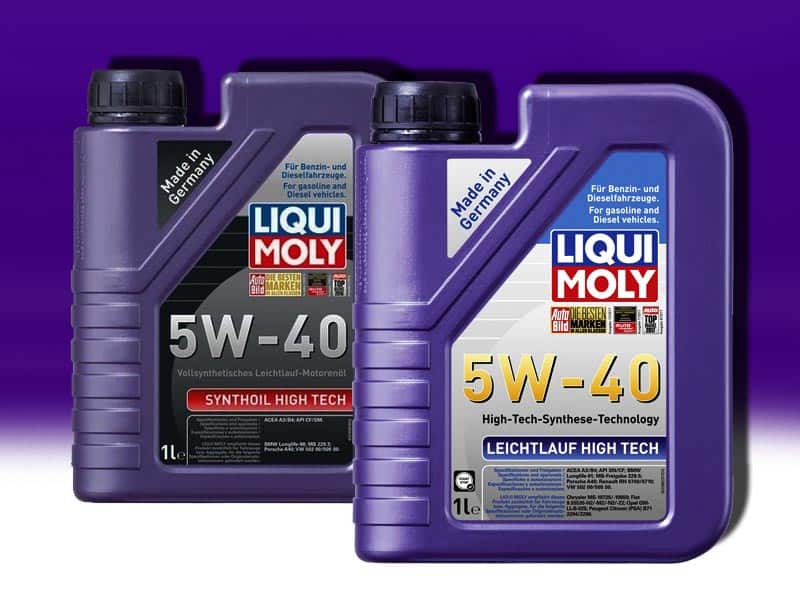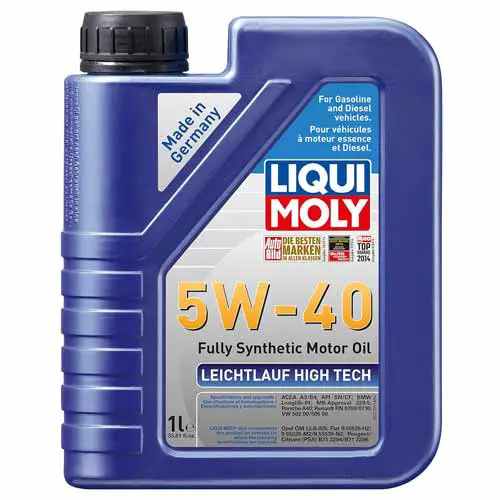These are wholly synthetic engine oils that can be utilized in gasoline along with diesel engines. Liqui Moly Synthoil High Tech provides excellent cleaning of deposits from the engine while Liquid Moly Leichtlauf High Tech generally focuses on shielding against engine wear and tear.
Synthoil due to its higher quantities of anti-wear additives gives excellent safeguarding from engine degradation.

The detergents are also present in good numbers to ensure proper cleaning of sludge and other impurities.
It has higher kinematic viscosity that enables it to perform dominantly during exaggerated temperature situations.
The catalytic converter performance of Leichtlauf is superior due to its less toxic ash formation.
The higher concentrations of detergents help it to reduce the sludge build-ups more diligently.
The oil has lower pre-mature burning due to its high flashpoint.
The higher TBN allows it to provide lower oil changing frequency. It provides higher value for the money due to its more affordable price.
Table of Contents
Side By Side Comparison


| Specifications | Synthoil High Tech | Leichtlauf High Tech |
| Type of oil | Entirely Synthetic | Entirely Synthetic |
| Engine Type | Gasoline/ Diesel | Gasoline / Diesel |
| Viscosity grades available | 5W-40 0W-30 0W-40 5W-30 | 5W-30 0W-20 10W-40 5W-40 |
| ILSAC | Unavailable | Unavailable |
| API | SM/ CF | SN/ CF |
| Oil change frequency (km) | 30,000 | 40,000 |
Starting with Viscosity
The capability of oil to disperse momentum through its layers is referred to as kinematic viscosity. The performance of the engine will be superior if it uses oil of greater kinematic viscosity.
Viscosity index is the measure of change in fluid kinematic viscosity relevant to the temperature fluctuation.
The higher viscosity index of the oil ensures minimal variations in its viscosity upon temperature elevation from normal to high. Pour point is the least temperature below which the oil is unable to flow.
The lower this pour point temperature, the better it is for the oil to perform dominantly in cold situations.
Synthoil has higher kinematic viscosities at 40 o C and 100 o C compared to its counterpart indicating its more dominant performance at both these specific temperatures.
On the contrary, Leichtlauf experiences a lower change in its kinematic viscosity when temperature increases from medium to very high.
The pour point temperatures of both the concerned oils are similar, depicting their identical performances under minimum temperature conditions.
| Contrasting oils (5W-40 Grade oils) | Kinematic Viscosity at 40 o C (mm2/s) | Kinematic Viscosity at 100 o C (mm2/s) | Viscosity index (VI) | Pour-point (o C) |
| Liqui Moly Synthoil High Tech | 90.2 | 14.5 | 167 | -45 |
| Liquid Moly Leichtlauf High Tech | 80.5 | 14 | 180 | -45 |
Catalytic Converter Performance Comparison
Zinc and phosphorus-based compounds that are being added to the oil as anti-wear agents, interact with the oxidized oil leading to the formation of poisonous ash. This ash launches into the converter and blocks it.
This significantly reduces catalytic converter efficiency.
Synthoil contains larger quantities of these anti-wearing compounds (zinc and phosphorus) that lead to more ash production thereby, resulting in lower catalytic converter performance as compared to other oil.
Conversely, the amount of these ZDDP compounds is relatively on the lower side in Leichtlauf which leads to better working of the catalytic converter due to its lower ash production.
Comparing Sludge production of oils
The dust or dirt present in the engine reacts with the oxidized oil to form a gelatinous fluid called sludge.
The sludge hinders the oil flow inside the engine acting as a hurdle in its proper working.
The production of sludge can be significantly minimized by adding detergents along with dispersants.
Their higher concentrations provide better protection from these sludge build-up problems.
Synthoil possesses these detergents and dispersants in lower amounts. So, the problem of sludge formation in the oil is relatively more, therefore, it is behind its competitor in terms of engine cleaning.
The detergent quantities are comparatively very high in Leichtlauf, resulting in superior protection against the issue of sludge emergence.
Comparing oil early burning protection
The early burning of oil is characterized by the concentrations of lighter molecules.
The oil containing these light molecules in higher numbers will be more volatile.
These molecules do not tolerate high-temperature situations and quickly vaporize.
The greater number of these molecules provide lower shielding from oil’s earlier burn-off.
The presence of these lightweight particles is faintly more in Synthoil causing it to reach its flashpoint at a relatively lower temperature. Thus, the oil provides lower protection from rapid oil burning.
Leichtlauf provides better sheltering against the pre-ignition of the oil due to its fewer light molecules enabling it to gain its flashpoint at a slightly higher temperature.
| Contrasting oils (5W-40 Grade oils) | Flash Point (Degrees Celsius) |
| Liqui Moly Synthoil High Tech | 230 |
| Liquid Moly Leichtlauf High Tech | 232 |
Engine Wear-off Protection Comparison
The friction between the moving parts of the engine is reduced by including anti-wearing additives in the oil. These additives form a fine layer around the moving components minimizing their contact with one another, thereby, leading to lower friction.
The availability of these additives in the oil in larger amounts causes better protection against the wear and tear of the engine.
The amount of wear-resisting agents is higher in Synthoil imparting a tough layer formation around the engine moving parts, providing superior shielding against engine degradation.
On the other hand, Leichtlauf contains these additives in relatively lower quantities. It leads to relatively higher friction between the metal parts, resulting in lower protection against the wear and tear of the engine.
Oil Change Frequency Comparison
Different factors such as immediate burning of the oil and concentrations of base additives added to the oil decide the oil’s change frequency.
The number of bases included in the oil is usually estimated from TBN (Total Base Number). However, their concentrations diminish over a period of time due to continuous encounters with acids. A greater TBN certifies longer durations of replacing the oil and vice versa.
The TBN of Synthoil is lower due to its lower base addition in comparison to its peer. The lower TBN provides a higher oil replacing frequency as it is required to change the oil after covering a distance of about 30,000 Km.
Meanwhile, Leichtlauf due to its higher base concentrations possesses a relatively higher TBN which ensures longer intervals of changing the oil. It needs to be exchanged after every 40,000 Km distance, more than that of its counterpart.
| Contrasting oils (5W-40 Grade oils) | TBN (Total Base Number) mg KOH/g |
| Liqui Moly Synthoil High Tech | 9.3 |
| Liquid Moly Leichtlauf High Tech | 11.3 |
Quick Summary
- Both oils are fully synthetic and are used for both types of engines, gasoline and diesel engines.
- Leichtlauf gives better working of catalytic converter due to its lower ZDDP compound concentrations.
- The engine cleaning performance of Leichtlauf is superior due to its greater detergent quantities.
- Leichtlauf provides higher protection against the rapid pre-burning of the oil.
- Anti-wearing additives are present in larger amounts in Synthoil which ensures its better resistance against engine wear and tear.
- Synthoil performs more confidently during both normal and high-temperature conditions due to its higher kinematic viscosity.
- The higher TBN of Leichtlauf ensures lower frequencies of changing the oil.
- Synthoil is marginally more expensive compared to its competitor.